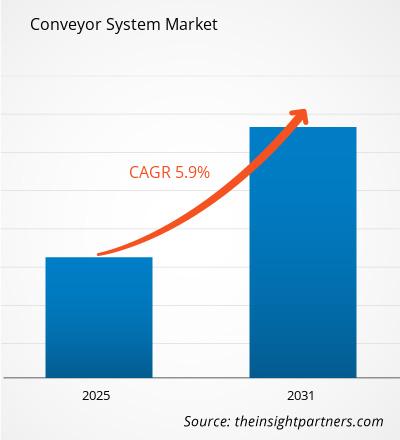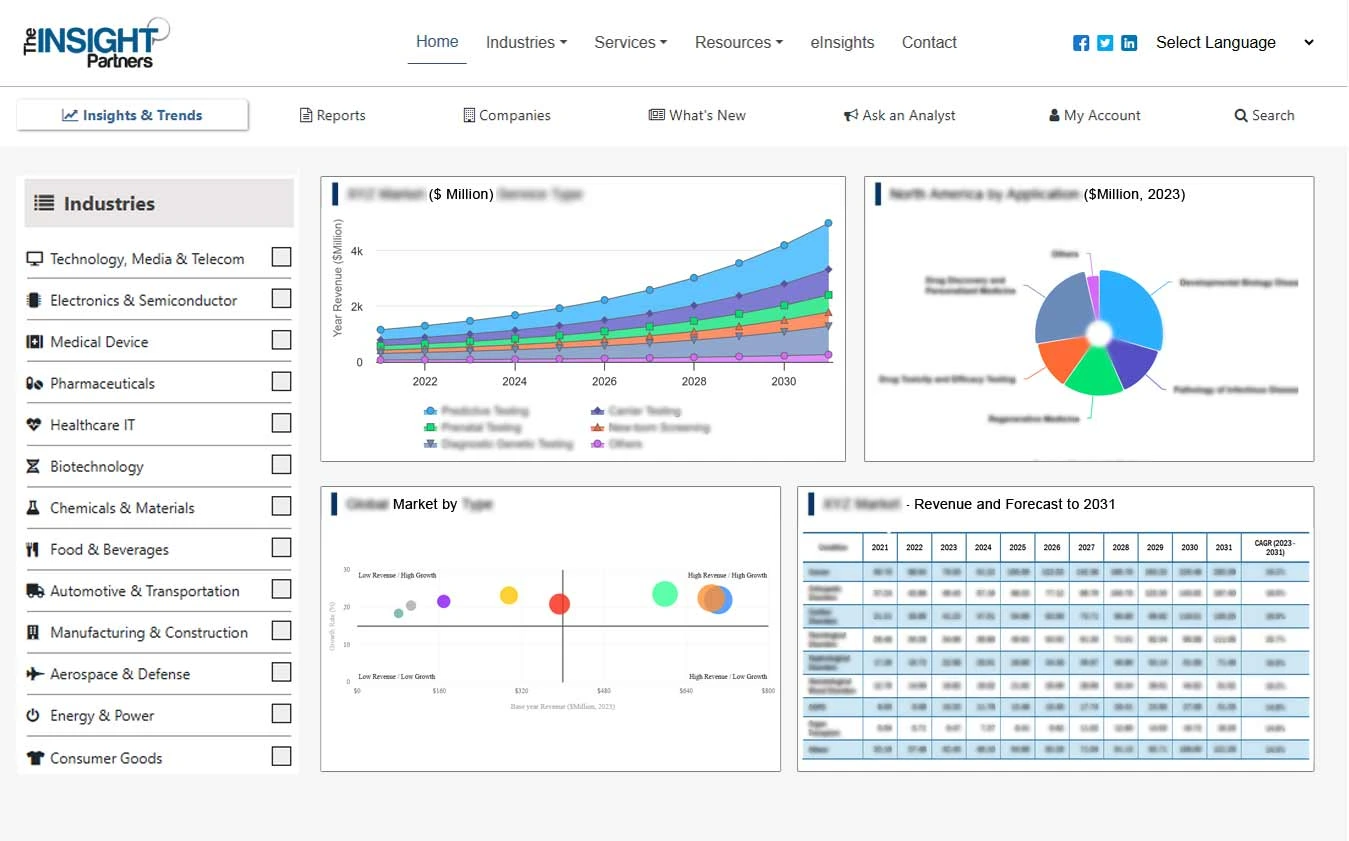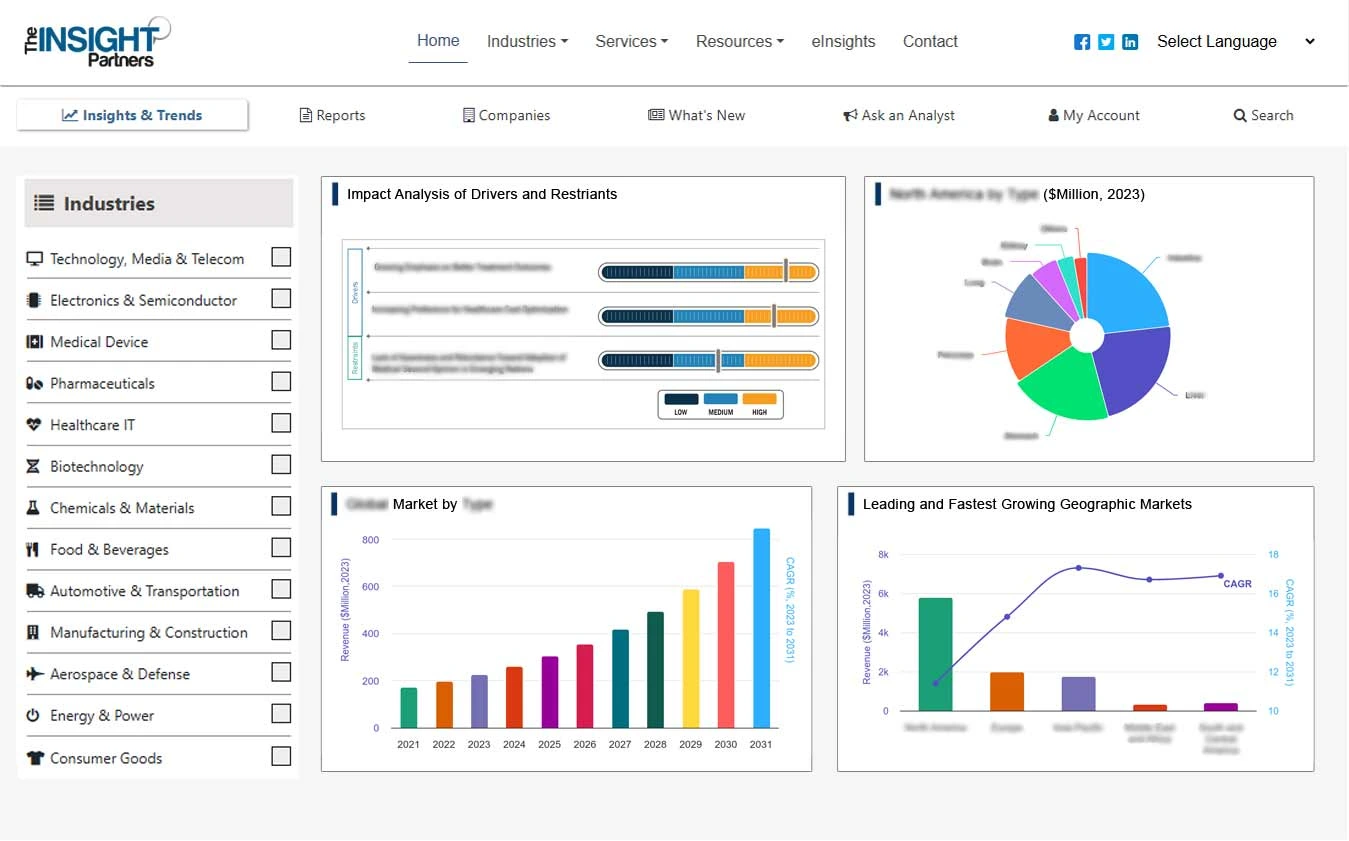من المتوقع أن يصل حجم سوق نظام النقل إلى 9.40 مليار دولار أمريكي بحلول عام 2031 من 6.47 مليار دولار أمريكي في عام 2024. ومن المتوقع أن يسجل السوق معدل نمو سنوي مركب بنسبة 5.7٪ خلال الفترة 2025-2031.
تحليل سوق أنظمة النقل
شهد سوق أنظمة النقل العالمي نموًا مطردًا بفضل تزايد الأتمتة الصناعية، وتوسع التجارة الإلكترونية، وتحديث مرافق التصنيع. ومع تزايد تعقيد سلاسل التوريد وحساسيتها للوقت، أصبحت أنظمة النقل ضرورية لانسيابية تدفق المواد وكفاءة العمليات. وتشمل القطاعات الرئيسية المحفزة للطلب: السيارات، والأغذية والمشروبات، والأدوية، والخدمات اللوجستية، والمطارات. تهيمن منطقة آسيا والمحيط الهادئ على السوق بفضل التصنيع السريع، بينما تتبعها أمريكا الشمالية وأوروبا بتحديثات مستمرة للأنظمة القديمة واعتماد متزايد للتقنيات الذكية.
نظرة عامة على سوق أنظمة النقل
نظام النقل هو حل ميكانيكي للمناولة يُستخدم لنقل المواد من نقطة إلى أخرى داخل المنشأة. تُستخدم هذه الأنظمة على نطاق واسع في قطاعات مثل التصنيع والتخزين وتجهيز الأغذية والتعدين والمطارات. تتوفر بأنواع مختلفة، بما في ذلك السيور والأسطوانات والناقلات العلوية، وهي مصممة لنقل البضائع بأشكال وأحجام وأوزان مختلفة. تُعزز أنظمة النقل الكفاءة التشغيلية من خلال أتمتة المهام المتكررة، وتقليل العمل اليدوي، وتقليل وقت المعالجة.
ستحصل على تخصيص لأي تقرير - مجانًا - بما في ذلك أجزاء من هذا التقرير، أو تحليل على مستوى الدولة، وحزمة بيانات Excel، بالإضافة إلى الاستفادة من العروض والخصومات الرائعة للشركات الناشئة والجامعات
سوق أنظمة النقل:

- احصل على أهم اتجاهات السوق الرئيسية لهذا التقرير.ستتضمن هذه العينة المجانية تحليل البيانات، بدءًا من اتجاهات السوق وحتى التقديرات والتوقعات.
محركات وفرص سوق أنظمة النقل
محركات السوق:
نمو التجارة الإلكترونية والتخزين:
برز النمو السريع للتجارة الإلكترونية كمحفز رئيسي لتوسع سوق أنظمة النقل العالمية. ومع تسارع تبني التقنيات الرقمية وتطور تفضيلات المستهلكين، يدفع النمو الكبير في نشاط التسوق الإلكتروني الشركات إلى تحسين بنيتها التحتية للتخزين والتوزيع، مع إعطاء الأولوية لقابلية التوسع والسرعة والكفاءة التشغيلية.ارتفاع الطلب على الأغذية والمشروبات والأدوية:
تشهد صناعات الأغذية والمشروبات والأدوية نموًا ملحوظًا، مما يؤثر بشكل مباشر على الطلب على أنظمة النقل الآلية. ومع توسع هذه القطاعات في عملياتها لتلبية الطلب العالمي المتزايد، أصبحت الحاجة إلى حلول مناولة مواد فعّالة وصحية وعالية السرعة أمرًا بالغ الأهمية.
فرص السوق:
ظهور الناقلات الذكية وتكامل الذكاء الاصطناعي:
يُمثل صعود النواقل الذكية المُدمجة مع الذكاء الاصطناعي فرصةً ثوريةً لسوق أنظمة النواقل. مع تركيز الصناعات على الأتمتة والكفاءة والصيانة التنبؤية ، تُحدث التقنيات المُعتمدة على الذكاء الاصطناعي، مثل التعلم الآلي والرؤية الحاسوبية ومعالجة اللغة الطبيعية وأتمتة العمليات الروبوتية، ثورةً في أنظمة النواقل.transformative opportunity for the conveyor system market. With industries focusing on automation, efficiency, and NLP), and robotic process automation (RPA) are revolutionizing conveyor systems.
تقرير تحليل تجزئة سوق أنظمة النقل
يُقسّم سوق أنظمة النقل إلى قطاعات مختلفة لتوضيح آلية عمله، وإمكانات نموه، وأحدث التوجهات. فيما يلي منهجية التقسيم القياسية المستخدمة في تقارير الصناعة:
حسب النوع:
ناقلات الحزام:
تستخدم الناقلات الحزامية حزامًا مستمرًا لنقل المواد من مكان إلى آخر.ناقلات الأسطوانة:
تتكون الناقلات الأسطوانية من العديد من البكرات الموضوعة بجوار بعضها البعض، مما يسمح للعناصر بالتحرك بسلاسة عبرها.ناقلات الأسطوانة:
يتم تعليق الناقلات العلوية من السقف أو هيكل الدعم، لنقل المنتجات فوق الأرض.آحرون:
تتضمن فئة "أخرى" الناقلات اللولبية، والناقلات المهتزة، والناقلات الهوائية.
حسب وضع التشغيل:
أنظمة النقل الأوتوماتيكية:
أنظمة النقل الأوتوماتيكية هي آلات آلية بالكامل تعمل على نقل المنتجات أو المواد دون مساعدة بشرية.الأنظمة شبه الآلية:
تجمع أنظمة النقل شبه الآلية بين التشغيل الآلي والتشغيل اليدوي. تُنجز بعض المهام تلقائيًا، بينما يتطلب بعضها الآخر تدخلًا بشريًا.الأنظمة اليدوية:
تعتمد أنظمة النقل اليدوية كليًا على الجهد البشري لنقل المنتجات. تتضمن هذه الأنظمة بكرات أو مسارات بسيطة يدفعها العمال أو يوجهونها من نقطة إلى أخرى.
حسب الصناعة:
- المأكولات والمشروبات
- السيارات
- المطارات
- الخدمات اللوجستية
- المعادن والتعدين
- آحرون
لكل نوع من الصناعات متطلبات خاصة لأنظمة النقل. وهذا يؤثر على التركيز على السرعة والراحة والاستدامة.
حسب الجغرافيا:
- أمريكا الشمالية
- أوروبا
- آسيا والمحيط الهادئ
- أمريكا الجنوبية والوسطى
- الشرق الأوسط وأفريقيا
رؤى إقليمية حول سوق أنظمة النقل
قام محللو شركة The Insight Partners بشرح شامل للاتجاهات والعوامل الإقليمية المؤثرة في سوق أنظمة النقل خلال فترة التوقعات. ويناقش هذا القسم أيضًا قطاعات سوق أنظمة النقل ونطاقه الجغرافي في أمريكا الشمالية، وأوروبا، وآسيا والمحيط الهادئ، والشرق الأوسط وأفريقيا، وأمريكا الجنوبية والوسطى.
نطاق تقرير سوق أنظمة النقل
| سمة التقرير | تفاصيل |
|---|---|
| حجم السوق في عام 2024 | 6.47 مليار دولار أمريكي |
| حجم السوق بحلول عام 2031 | 9.40 مليار دولار أمريكي |
| معدل النمو السنوي المركب العالمي (2025 - 2031) | 5.7% |
| البيانات التاريخية | 2021-2023 |
| فترة التنبؤ | 2025-2031 |
| القطاعات المغطاة | حسب النوع
|
| المناطق والبلدان المغطاة | أمريكا الشمالية
|
| قادة السوق وملفات تعريف الشركات الرئيسية |
|
كثافة اللاعبين في سوق أنظمة النقل: فهم تأثيرها على ديناميكيات الأعمال
يشهد سوق أنظمة النقل نموًا سريعًا، مدفوعًا بتزايد طلب المستخدم النهائي نتيجةً لعوامل مثل تطور تفضيلات المستهلكين، والتقدم التكنولوجي، وزيادة الوعي بمزايا المنتج. ومع تزايد الطلب، تعمل الشركات على توسيع عروضها، والابتكار لتلبية احتياجات المستهلكين، والاستفادة من الاتجاهات الناشئة، مما يعزز نمو السوق.

- احصل على نظرة عامة على أهم اللاعبين الرئيسيين في سوق أنظمة النقل
تحليل حصة سوق أنظمة النقل حسب المنطقة الجغرافية
يشهد سوق أنظمة النقل في منطقة آسيا والمحيط الهادئ نموًا ملحوظًا، ويعود ذلك بشكل رئيسي إلى توسع قطاع التجارة الإلكترونية. كما توفر الأسواق الناشئة في أمريكا الجنوبية والوسطى والشرق الأوسط وأفريقيا فرصًا واعدة لمقدمي أنظمة النقل لتوسيع عملياتهم.
يختلف نمو سوق أنظمة النقل من منطقة لأخرى نظرًا لتوسع قطاعي التجارة الإلكترونية والتخزين في مختلف البلدان. فيما يلي ملخص لحصة السوق واتجاهاتها حسب المنطقة:
1. أمريكا الشمالية
الحصة السوقية:
تمتلك حصة كبيرة من السوق العالميةالعوامل الرئيسية:
- قاعدة صناعية قوية في صناعة السيارات والأغذية والمشروبات والتصنيع.
- إن ارتفاع تكاليف العمالة ونقص القوى العاملة الماهرة هو السبب وراء الأتمتة.
- نمو التجارة الإلكترونية وعمليات اللوجستيات عالية السرعة.
الاتجاهات:
ظهور أنظمة النقل المدمجة والقابلة للتشكيل في مراكز التوزيع الصغيرة الحضرية.
2. أوروبا
الحصة السوقية:
حصة كبيرة بسبب اللوائح الصارمة المبكرة للاتحاد الأوروبيالعوامل الرئيسية:
- تتبنى قطاعات صناعة السيارات وتجهيز الأغذية الراسخة الأتمتة الدقيقة.
- تعمل اللوائح الصارمة المتعلقة بالسلامة والبيئة على تعزيز حلول الناقل المتقدمة.
- تزايد استخدام تقنيات الصناعة 4.0 وتحديث الأنظمة القديمة.
الاتجاهات:
اعتماد محركات موفرة للطاقة وأنظمة مجهزة بأجهزة استشعار لتحقيق الاستدامة والصيانة التنبؤية.
3. آسيا والمحيط الهادئ
الحصة السوقية:
المنطقة الأسرع نموًا مع حصة سوقية مهيمنةالعوامل الرئيسية:
- التصنيع السريع في الصين والهند وفيتنام وجنوب شرق آسيا.
- تعمل مبادرات التصنيع والأتمتة التي تقودها الحكومة على تعزيز التبني.
- النمو في البنية التحتية للتجارة الإلكترونية والتخزين.
الاتجاهات:
التحول نحو أنظمة النقل المعيارية عالية الإنتاجية لأتمتة الخدمات اللوجستية.
4. أمريكا الجنوبية والوسطى
الحصة السوقية:
على الرغم من صغر حجمها، إلا أنها تنمو بسرعةالعوامل الرئيسية:
- توسيع عمليات التعدين والزراعة ومناولة المواد السائبة.
- تحديث البنية التحتية اللوجستية ومرافق التخزين.
- الضغط لتقليل تكاليف العمل اليدوي من خلال الأتمتة.
الاتجاهات:
تطوير مراكز التوحيد الإقليمية باستخدام أنظمة النقل الآلية.
5. الشرق الأوسط وأفريقيا
الحصة السوقية:
سوق متنامية مع تقدم مطردالعوامل الرئيسية:
- المشاريع الصناعية والبنية الأساسية الضخمة في مختلف المجالات اللوجستية والمطارات والتصنيع.
- زيادة الأتمتة لمعالجة قيود العمالة وتحسين الكفاءة.
- الاستثمارات العامة والخاصة في مناطق التخزين والخدمات اللوجستية.
الاتجاهات:
نمو الشراكات المحلية لنشر أنظمة النقل المخصصة في المناطق الصناعية.
كثافة اللاعبين في سوق أنظمة النقل: فهم تأثيرها على ديناميكيات الأعمال
كثافة السوق العالية والمنافسة
إن المنافسة شديدة بسبب اللاعبين الراسخين مثل Daifuku Co Ltd وKion Group AG وMetso Outotec Corp. كما يضيف المزودون الإقليميون والمتخصصون مثل Swisslog Holding AG (ألمانيا) وFives SAS (فرنسا) إلى المشهد التنافسي عبر المناطق.
هذا المستوى العالي من المنافسة يحث الشركات على التميز من خلال تقديم:
- الاستثمارات في أنظمة النقل
- أنظمة موفرة للطاقة وصديقة للبيئة.
الفرص والتحركات الاستراتيجية
- ظهور الناقلات الذكية وتكامل الذكاء الاصطناعي.
- التركيز المتزايد على الاستدامة.
الشركات الرئيسية العاملة في سوق نظام النقل هي:
- شركة دايفوكو المحدودة – أوساكا، اليابان
- KION Group AG – فرانكفورت أم ماين، ألمانيا
- شركة ميتسو أوتوتيك – هلسنكي، فنلندا
- شركة هانيويل الدولية - شارلوت، كارولاينا الشمالية، الولايات المتحدة
- شركة إنترول القابضة المحدودة – سانت أنتونينو، سويسرا
- فايفز ساس – باريس، فرنسا
- مجموعة SSI SCHAEFER – نيونكيرشن، ألمانيا
- شركة سويس لوج القابضة – بوشس، سويسرا
- شركة تي جي دبليو لوجيستكس جروب المحدودة – فيلس، النمسا
- Vanderlande Industries BV – فيغيل، هولندا
إخلاء المسؤولية: الشركات المذكورة أعلاه ليست مرتبة بأي ترتيب معين.
الشركات الأخرى التي تم تحليلها أثناء البحث:
- شركة دورنر للتصنيع
- FlexLink (شركة تابعة لشركة Coesia)
- شركة هيترول كونفيور المحدودة
- مجموعة إم كيه للتكنولوجيا
- شركة لويكو
- شركة وينرايت (شركة تابعة لمجموعة دايفوكو)
- ناقلات FMH
- شركة أشورث براذرز
- شانتلاند-MHS
- فيكوبلان، ذ.م.م
- دايناكون (شركة النقل الديناميكي)
- شركة نيوهاوس نيوتيك المحدودة
- شنايتمان ماشيننباو جي إم بي إتش
- معدات إيجلستون
- شركة بونتينغ ماجنتكس
- كاليتا للطيران
أخبار سوق أنظمة النقل والتطورات الأخيرة
تقوم شركة ليبهير ببناء مركز لوجستي جديد في توبيلو، ميسيسيبي –
تتولى شركة SSI SCHAEFER مسؤولية تقديم حلول اللوجستيات الداخلية. وبصفتها شركةً مُتكاملة للأنظمة، تُقدم SSI SCHAEFER حلولاً لوجستية داخلية مؤتمتة بالكامل، تتضمن مستودعات عالية السعة ومستودعات مكوكية، وأنظمة نقل، ونظام إدارة المستودعات الموسّع من SAP لضمان عمليات مستودعات عالية الكفاءة والشفافية.تعاون بين Coop وSSI SCHAEFER لتعزيز الشراكة من خلال تحديث WAMAS على نطاق واسع.
ينتقل التعاون بين مجموعة Swiss Coop، وهي شركة دولية للإنتاج والتجزئة، وشركة SSI SCHAEFER، أحد المزودين الرائدين عالميًا لحلول اللوجستيات الداخلية الشاملة، إلى المستوى التالي: من خلال طلب ترقية الإصدار الشامل لبرنامج WAMAS اللوجستي الداخلي، تضع مجموعة Coop ثقتها في مشهد برمجي متجانس ومستقبلي في عملياتها اللوجستية الداخلية.
تغطية تقرير سوق أنظمة النقل والمنتجات النهائية
يقدم تقرير "حجم سوق نظام النقل والتوقعات (2021-2031)" تحليلاً مفصلاً للسوق يغطي المجالات التالية:
- حجم سوق أنظمة النقل والتوقعات على المستويات العالمية والإقليمية والوطنية لجميع قطاعات السوق الرئيسية التي يغطيها النطاق
- اتجاهات سوق أنظمة النقل، بالإضافة إلى ديناميكيات السوق مثل المحركات والقيود والفرص الرئيسية
- تحليل مفصل لـ PEST و SWOT
- تحليل سوق أنظمة النقل الذي يغطي اتجاهات السوق الرئيسية والإطار العالمي والإقليمي والجهات الفاعلة الرئيسية واللوائح والتطورات الأخيرة في السوق
- تحليل المشهد الصناعي والمنافسة الذي يغطي تركيز السوق، وتحليل خريطة الحرارة، واللاعبين البارزين، والتطورات الأخيرة لسوق نظام النقل
- ملفات تعريف الشركة التفصيلية
- التحليل التاريخي (سنتان)، السنة الأساسية، التوقعات (7 سنوات) مع معدل النمو السنوي المركب
- تحليل PEST و SWOT
- حجم السوق والقيمة / الحجم - عالميًا وإقليميًا وقطريًا
- الصناعة والمنافسة
- مجموعة بيانات Excel



Report Coverage
Revenue forecast, Company Analysis, Industry landscape, Growth factors, and Trends

Segment Covered
This text is related
to segments covered.

Regional Scope
North America, Europe, Asia Pacific, Middle East & Africa, South & Central America

Country Scope
This text is related
to country scope.
الأسئلة الشائعة
The market is primarily driven by:
1. Growth of E-Commerce and Warehousing:
The accelerated expansion of e-commerce has become a pivotal force driving the global conveyor system industry. With the rising penetration of digital technologies and shifting consumer dynamics, the substantial uptick in online retail activity is prompting enterprises to upgrade their logistics infrastructure, focusing on enhanced capacity, speed, and operational efficiency.
2. Surging Demand in Food & Beverage and Pharmaceuticals:
The rapid growth of the food & beverage and pharmaceutical sectors is significantly fueling the demand for automated conveyor systems. As these industries scale their operations to meet rising global consumption, the need for streamlined, sanitary, and high-throughput material handling solutions has become increasingly critical.
As of 2025:
1. Asia Pacific: Asia Pacific is experiencing rapid growth in the conveyor system market, propelled by accelerated industrialization, booming e-commerce, and expanding infrastructure across developed and emerging economies.
2. North America: The North American conveyor system market expansion is driven primarily by the growing emphasis on automation and operational efficiency across industries such as automotive, e-commerce, food and beverage, and pharmaceuticals.
3. Europe: In Europe, the conveyor system market is largely influenced by regulatory pressures, strong industrial automation uptake, and an ongoing shift toward sustainable and digitized operations.
Major players include Daifuku Co., Ltd., KION Group AG, Honeywell International Inc., Interroll Holding AG, and Fives Group (Fives SAS).
Automatic conveyor systems move products or materials without human help. These systems are controlled by software, sensors, and motors, making them fast, efficient, and accurate.
As of 2024, the global Conveyor System market is valued at approximately USD 6.47 billion. It is projected to reach USD 9.40 billion by 2031, growing at a compound annual growth rate (CAGR) of 5.7% during the forecast period from 2025 to 2031.
Challenges include:
1. High Initial Investment and Integration Costs: One of the key restraints limiting the widespread adoption of Conveyor System—particularly among small and mid-sized enterprises—is the high initial investment and complexity of integration.
Key industries utilizing Conveyor System include:
1. Food and Beverage: The food and beverage industry uses conveyor systems to move products through processing, packaging, and distribution stages.
2. Automotive: The automotive industry is one of the largest users of conveyor systems. These systems are used throughout manufacturing plants to transport car parts, engines, and entire vehicles during assembly.
3. Airports: Conveyor systems are crucial in airport operations, especially baggage handling.
4. Logistics: The logistics industry uses conveyor systems extensively in warehouses, distribution centers, and sorting facilities to move goods quickly and efficiently.
5. Metals and Mining: Conveyor systems transport raw materials such as ores, coal, and minerals in the metals and mining industry.
6. Others: This category includes industries such as pharmaceuticals, retail, agriculture, and electronics. Each of these sectors uses conveyor systems tailored to specific needs, such as moving delicate items, handling chemicals, or organizing small parts.
The List of Companies - Conveyor System Market
- Daifuku Co Ltd
- Kion Group AG
- Metso Outotec Corp
- Honeywell International Inc
- Interroll Holding GmbH
- Fives SAS
- SSI SCHAEFER Group
- Swisslog Holding AG
- TGW Logistics Group GmbH
- Vanderlande Industries BV
The Insight Partners performs research in 4 major stages: Data Collection & Secondary Research, Primary Research, Data Analysis and Data Triangulation & Final Review.
- Data Collection and Secondary Research:
As a market research and consulting firm operating from a decade, we have published and advised several client across the globe. First step for any study will start with an assessment of currently available data and insights from existing reports. Further, historical and current market information is collected from Investor Presentations, Annual Reports, SEC Filings, etc., and other information related to company’s performance and market positioning are gathered from Paid Databases (Factiva, Hoovers, and Reuters) and various other publications available in public domain.
Several associations trade associates, technical forums, institutes, societies and organization are accessed to gain technical as well as market related insights through their publications such as research papers, blogs and press releases related to the studies are referred to get cues about the market. Further, white papers, journals, magazines, and other news articles published in last 3 years are scrutinized and analyzed to understand the current market trends.
- Primary Research:
The primarily interview analysis comprise of data obtained from industry participants interview and answers to survey questions gathered by in-house primary team.
For primary research, interviews are conducted with industry experts/CEOs/Marketing Managers/VPs/Subject Matter Experts from both demand and supply side to get a 360-degree view of the market. The primary team conducts several interviews based on the complexity of the markets to understand the various market trends and dynamics which makes research more credible and precise.
A typical research interview fulfils the following functions:
- Provides first-hand information on the market size, market trends, growth trends, competitive landscape, and outlook
- Validates and strengthens in-house secondary research findings
- Develops the analysis team’s expertise and market understanding
Primary research involves email interactions and telephone interviews for each market, category, segment, and sub-segment across geographies. The participants who typically take part in such a process include, but are not limited to:
- Industry participants: VPs, business development managers, market intelligence managers and national sales managers
- Outside experts: Valuation experts, research analysts and key opinion leaders specializing in the electronics and semiconductor industry.
Below is the breakup of our primary respondents by company, designation, and region:

Once we receive the confirmation from primary research sources or primary respondents, we finalize the base year market estimation and forecast the data as per the macroeconomic and microeconomic factors assessed during data collection.
- Data Analysis:
Once data is validated through both secondary as well as primary respondents, we finalize the market estimations by hypothesis formulation and factor analysis at regional and country level.
- Macro-Economic Factor Analysis:
We analyse macroeconomic indicators such the gross domestic product (GDP), increase in the demand for goods and services across industries, technological advancement, regional economic growth, governmental policies, the influence of COVID-19, PEST analysis, and other aspects. This analysis aids in setting benchmarks for various nations/regions and approximating market splits. Additionally, the general trend of the aforementioned components aid in determining the market's development possibilities.
- Country Level Data:
Various factors that are especially aligned to the country are taken into account to determine the market size for a certain area and country, including the presence of vendors, such as headquarters and offices, the country's GDP, demand patterns, and industry growth. To comprehend the market dynamics for the nation, a number of growth variables, inhibitors, application areas, and current market trends are researched. The aforementioned elements aid in determining the country's overall market's growth potential.
- Company Profile:
The “Table of Contents” is formulated by listing and analyzing more than 25 - 30 companies operating in the market ecosystem across geographies. However, we profile only 10 companies as a standard practice in our syndicate reports. These 10 companies comprise leading, emerging, and regional players. Nonetheless, our analysis is not restricted to the 10 listed companies, we also analyze other companies present in the market to develop a holistic view and understand the prevailing trends. The “Company Profiles” section in the report covers key facts, business description, products & services, financial information, SWOT analysis, and key developments. The financial information presented is extracted from the annual reports and official documents of the publicly listed companies. Upon collecting the information for the sections of respective companies, we verify them via various primary sources and then compile the data in respective company profiles. The company level information helps us in deriving the base number as well as in forecasting the market size.
- Developing Base Number:
Aggregation of sales statistics (2020-2022) and macro-economic factor, and other secondary and primary research insights are utilized to arrive at base number and related market shares for 2022. The data gaps are identified in this step and relevant market data is analyzed, collected from paid primary interviews or databases. On finalizing the base year market size, forecasts are developed on the basis of macro-economic, industry and market growth factors and company level analysis.
- Data Triangulation and Final Review:
The market findings and base year market size calculations are validated from supply as well as demand side. Demand side validations are based on macro-economic factor analysis and benchmarks for respective regions and countries. In case of supply side validations, revenues of major companies are estimated (in case not available) based on industry benchmark, approximate number of employees, product portfolio, and primary interviews revenues are gathered. Further revenue from target product/service segment is assessed to avoid overshooting of market statistics. In case of heavy deviations between supply and demand side values, all thes steps are repeated to achieve synchronization.
We follow an iterative model, wherein we share our research findings with Subject Matter Experts (SME’s) and Key Opinion Leaders (KOLs) until consensus view of the market is not formulated – this model negates any drastic deviation in the opinions of experts. Only validated and universally acceptable research findings are quoted in our reports.
We have important check points that we use to validate our research findings – which we call – data triangulation, where we validate the information, we generate from secondary sources with primary interviews and then we re-validate with our internal data bases and Subject matter experts. This comprehensive model enables us to deliver high quality, reliable data in shortest possible time.
 احصل على عينة مجانية لهذا التقرير
احصل على عينة مجانية لهذا التقرير